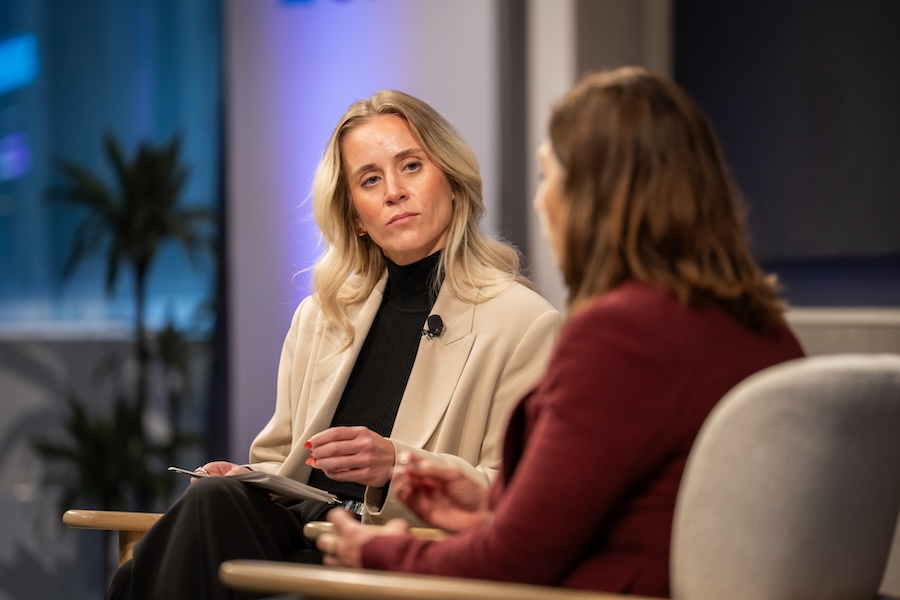The Biggest Challenges (and Chances) for HR Leaders in 2026 and Beyond


Ruth Ferguson, EVP and head of HR for consumer, small & business banking at Wells Fargo uses ChatGPT multiple times a day in her personal life, for everything from planning vacations to finding recipes, and other everyday tasks. This experimentation with AI outside the office, she says, is exactly what employees need to do to overcome their fears about AI.
“It’s sort of like conquering all your fears,” Ferguson said during a fireside chat at From Day One’s Midtown Manhattan conference. “The more you use the prompts, the more you use your creative mindset on how to ask questions or challenge it. It’s so empowering to see the capacity that it frees up.” The conversation, moderated by Cadie Thompson, executive editor at Business Insider, explored how Wells Fargo is navigating AI adoption, generational workforce changes, and employee engagement during a time of rapid change.
Embracing AI as an Enabler, Not a Threat
The fear of AI is natural and rooted in historical precedent, says Ferugson. “A hundred years ago, we were a farming and manufacturing economy, and here we are, 100 years later, and those jobs have changed,” she said. But the key, she says, is developing skills and mindsets that AI cannot replicate.
While AI excels at repetitive tasks and data amalgamation, humans bring critical reasoning, empathy, and nuanced decision-making to complex problems. “Some problems have multiple answers,” Ferguson said. “How you balance and prioritize on the spectrum of what’s important— that’s where the human mind comes in.”
Leaders play a crucial role in helping employees understand that AI is a tool to assist them, not their replacement. When used properly, AI creates room for employees to use their higher-level thinking. Her advice for getting friendly with AI? Just start using it. At Wells Fargo, leaders encourage employees to practice with AI tools both at work and in their personal lives, embracing a “fail fast” mentality that builds comfort through experimentation.
The Entry-Level Talent Advantage
Despite efficiency pressures leading many companies to cap headcount and reduce middle management, Ferguson sees entry-level hiring as critical to Wells Fargo’s future. She serves on the board of Dickinson College in Pennsylvania, and recently witnessed students envisioning how AI could propel society forward in healthcare and beyond. “This generation graduating college and university, they’ve never known life without a cell phone or the internet,” Ferguson said. “We can learn from this generation.” Their native fluency with technology and optimistic view of AI’s potential position them to lead companies in creative problem-solving, which ultimately serves customers more effectively.
However, this generation also presents distinct challenges. Ferguson identified focus and prioritization as the biggest hurdles. “We have raised a generation who are brilliant multitaskers,” she observed, describing young workers juggling multiple apps, learning TikTok dances, and scanning news simultaneously. “How do we focus? Because in corporate America, and in particular in banking, I need to be focused on my customer and client.”
Redefining Workplace Loyalty
The conversation turned to whether workplace loyalty still exists in an era of performance metrics and job-hopping. Ferguson’s answer: loyalty exists, but it is different.
“Loyalty, spending 25, 30, 35 years at a company, doesn’t happen as much anymore,” she said. Instead, Wells Fargo defines loyalty through “mutual accountability and mutual success,” ensuring employees believe their individual success is tied to company outcomes, and vice versa.

“If we approach loyalty from a purely timeframe perspective, the risk we run is people who are quiet quitters,” Ferguson said, describing employees who simply clock in and out without contributing meaningfully. In other words: workplace loyalty is not about time spent at a company, it’s about personal investment in it.
This philosophy has helped Wells Fargo rebuild its culture. Ferguson, who joined in 2021, described how CEO Charlie Scharf’s unwavering commitment to building a culture of risk management and customer focus has unified the workforce. When the Federal Reserve’s asset cap was lifted earlier in the year, employees felt genuine pride in their collective accomplishment.
Supporting Managers in a Changing Workplace
Ferguson’s biggest current challenge? Empowering burnt-out managers navigating unprecedented uncertainty. “Being a manager now doesn’t simply mean just getting the job done, but it does mean motivating a workforce,” she said. “Some of them are really tired, and they themselves are struggling.”
Her remedy includes consistent appreciation, clear skill development pathways, and executive visibility. “If we don’t spend the time empowering our managers and training our managers, we will fall behind,” she said. Sometimes, she says, addressing the challenge is as simple as saying thank you and being present with teams, putting phones down, making eye contact, and truly listening to what’s on people’s minds. And that is exactly the type of human connection that AI cannot replace.
Grace Turney is a St. Louis-based writer, artist, and former librarian. See more of her work at graceturney17.wixsite.com/mysite.
(Photos by Josh Larson for From Day One)
The From Day One Newsletter is a monthly roundup of articles, features, and editorials on innovative ways for companies to forge stronger relationships with their employees, customers, and communities.